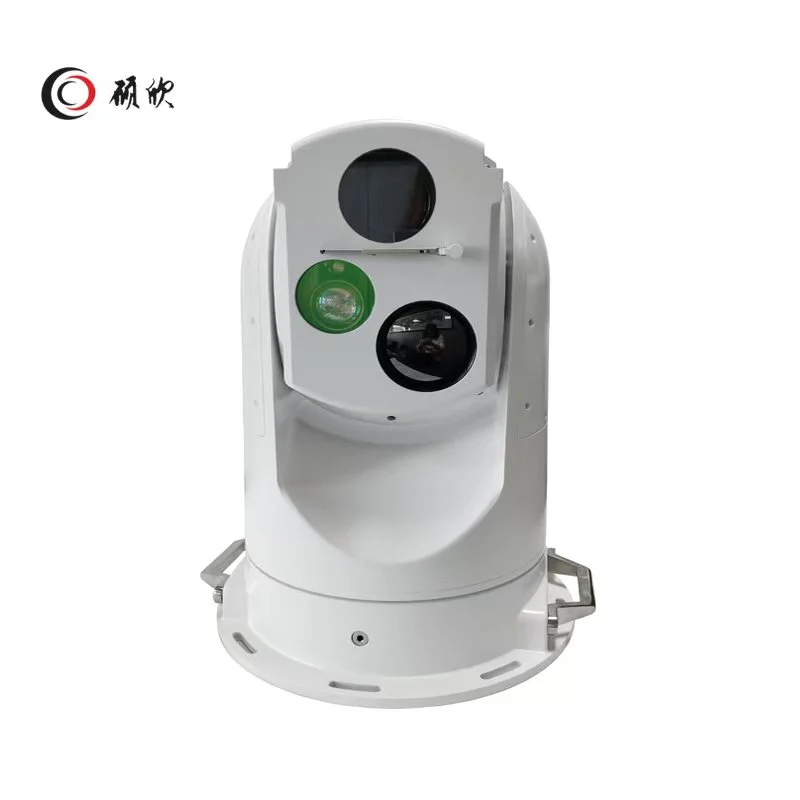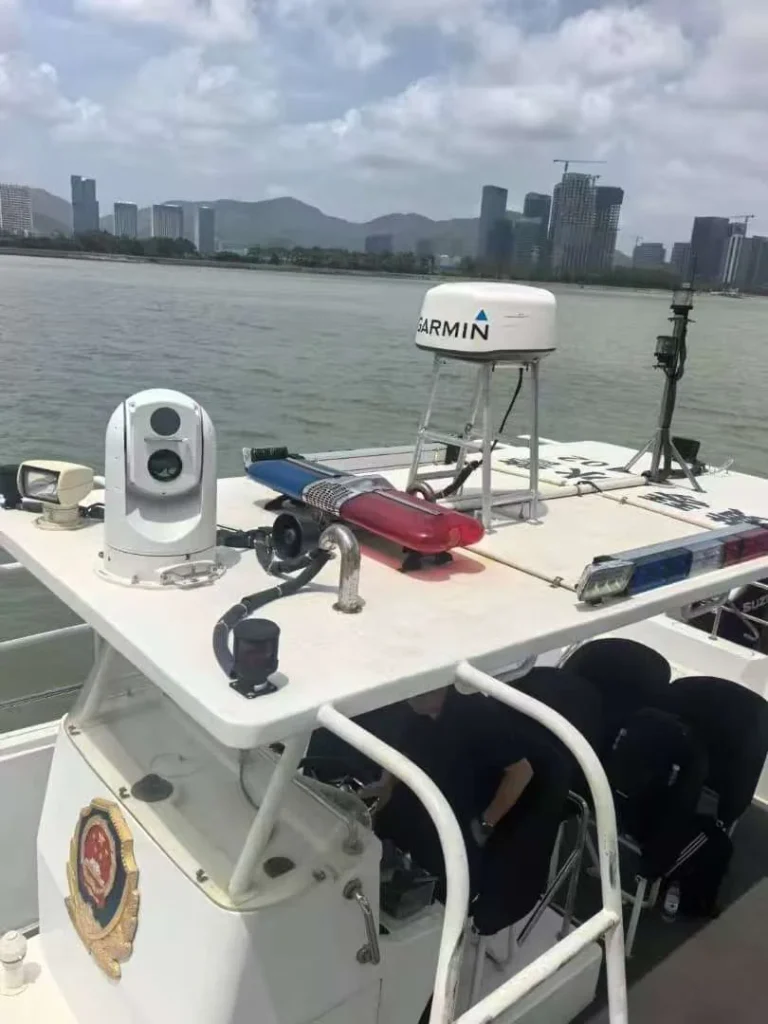كاميرات التصوير الحراري مع القدرات طويلة المدى لا غنى عنها للسفن البحرية. هذه الأجهزة المبتكرة تكتشف الطاقة الحرارية من الأجسام والأفراد، مما يتيح الرؤية عندما تفشل الأساليب التقليدية. ولا يزال أدائها موثوقا به في ظروف بحرية صعبة، مما يوفر مزايا حاسمة للملاحة والسلامة.
فهم أجهزة التصوير الحراري طويلة المدى
أنظمة الكشف الحراري ذات القدرات الموسعة المدى هي أدوات متخصصة تلتقط التوقيعات الحرارية من الأجسام والكائنات الحية. تختلف هذه الأجهزة بشكل أساسي عن الكاميرات البصرية التقليدية في مبدأ تشغيلها.
أهمية الرؤية الحرارية للعمليات البحرية
يمثل الملاحة في الممرات المائية تحديات رؤية فريدة تحلها تكنولوجيا التصوير الحراري بفعالية. هذه أنظمة متقدمة الكشف عن الإشعاع الحراري بدلا من الاعتماد على الضوء المرئي، مما يوفر مزايا حاسمة في ظروف صعبة.
الميزات الرئيسية لكاميرات حرارية PTZ طويلة المدى

كاميرات حرارية PTZ طويلة المدى لها ميزات رائعة للوظائف البحرية:
- ميزة Pan-Tilt-Zoom: إنها تتأرجح على اليسار واليمين أو تميل للأعلى والأسفل. يمكنك التكبير لرؤية الأشياء البعيدة.
- أجهزة استشعار قويةهذه التقاط الاختلافات الحرارية الصغيرة، حتى يمكنك رؤية الأشياء من بعيد جدا.
- تصميم مستشعر مزدوجبعض المزيج من الكاميرات الحرارية والكاميرات العادية، مما يعطيك المزيد من الطرق لرؤية.
- بناء صعبصممت للتعامل مع الهواء المالح والطقس الرطب ودرجات الحرارة الساخنة أو الباردة.
ما الذي يجب مراعاته عند اختيار الكاميرا الحرارية البحرية؟
اختيار الكاميرا المناسبة يعني التفكير في بعض الأشياء المهمة:
ما مدى أهمية نطاق الكشف ومجال الرؤية؟
نطاق الكشف هو مدى قدرة الكاميرا على رؤية شيء ما. مجال الرؤية هو مدى عرض المنطقة التي يغطيها. بالنسبة للوظائف البعيدة، اختر كاميرا ترى مسافة طويلة ولكن تركز على مكان أصغر. هذا يساعدك على رؤية الأشياء بوضوح من بعيد.
هل دقة الصورة مهمة؟
الصور الواضحة مهمة جدا. الدقة العالية تعني صور أكثر وضوحاً، وهو أمر رائع للكشف عن الأشياء الصغيرة أو البعيدة. اختر كاميرا مع التصوير الحراري عالي الوضوح لتحقيق أفضل النتائج.
هل يجب أن تكون مقاومة الطقس أولوية؟
المحيط صعب على المعدات. تحتاج الكاميرا إلى التعامل مع الماء والملح والطقس البري. ابحث عن واحد مع تصنيف IP عالي ، مما يظهر أنه تم بناؤه لتستمر في ظروف قاسية.
هل يمكن دمجها مع أنظمة الملاحة؟
الكاميرا التي تتصل بأدوات الملاحة في قاربك تجعل الأمور أسهل. يسمح لك بمشاهدة كل شيء والتحكم فيه من مكان واحد ، مما يوفر الوقت والجهد.
استكشاف حلول كاميرا حرارية PTZ طويلة المدى من Shuoxin
إذا كنت بحاجة إلى كاميرات قوية للعمل البحري، Shuoxin لديها كاميرات حرارية PTZ طويلة المدى كبيرة بنيت لظروف البحر القاسية.
ما الذي يجعل خط منتجات Shuoxin يبرز؟
Shuoxin يبني كاميرات حرارية عالية الجودة أنها سهلة الاستخدام وقوية. تم تصميم كاميرات حرارية PTZ طويلة المدى لدقة وقوة، مما يجعلها مثالية للبيئة الصعبة للمحيط.
الميزات الرئيسية للكاميرات الحرارية PTZ طويلة المدى Shuoxin
- أجهزة استشعار الحرارة الكبيرةهذه التقاط تغييرات حرارية صغيرة، حتى من بعيد جدا.
- تصميم قويقضاياهم تتحمل الطقس السيئ والهواء المالح، لذلك تستمر لفترة طويلة.
- اتصال سهليعملون بسلاسة مع أنظمة الملاحة أو الأمن في قاربك.
لماذا تختار منتجات شوكسين للتطبيقات البحرية؟
كاميرات Shuoxin موثوقة وتعمل بشكل جيد. إنهم يركزون على أفكار جديدة، لذلك يمكنك الحصول على أحدث التقنيات للبقاء آمنًا والعمل بشكل أفضل على الماء. تم تصميمها للتعامل مع التحديات البحرية الحقيقية ، مما يجعلها خيار ذكي.
كيف تقارن نماذج Shuoxin للاحتياجات المختلفة؟
شوكسين لديها الكثير من النماذج للقوارب المختلفة. بعضها رائع لرؤية بعيد، في حين أن البعض الآخر أصغر للقوارب الصغيرة. يتم تصميم كل واحد بعناية للعمل بشكل جيد لجميع أنواع الوظائف البحرية ، حتى تتمكن من العثور على الوظيفة المثالية لك.
تطبيقات الكاميرات الحرارية طويلة المدى في الإعدادات البحرية
كيف يمكن تحسين الملاحة الليلية والسلامة؟
الإبحار في الليل صعب لأنك لا تستطيع رؤية الكثير. الكاميرات الحرارية طويلة المدى تجعل من السهل العثور على الحرارة بدلا من الضوء. تظهر لك أشياء مثل الأشجار العائمة أو القوارب الأخرى أو حتى الحيوانات التي قد تسبب مشاكل. مع PTZ ، يمكنك النظر حولك دون أن تفوت أي شيء. يمكنك أيضًا التكبير للتحقق من أي شيء غريب ، مما يبقي رحلتك آمنة.
كيف تدعم عمليات البحث والإنقاذ؟
عندما يضيع شخص ما في البحر ، فإن الوقت مهم للغاية. الكاميرات الحرارية هي مساعدة كبيرة هنا. يكتشفون الحرارة من الناس، حتى في الظلام الكامل أو الطقس السيئ مثل الضباب أو المطر. استشعاراتها القوية تلتقط اختلافات حرارية صغيرة من بعيد. بعضها يحتوي على أجهزة استشعار مزدوجة، والتي تخلط بين الصور الحرارية والمنتظمة لتحقيق دقة أفضل. هذا يساعد الإنقاذين على العثور على الناس بسرعة وإنقاذ الأرواح.
ما هو الدور الذي تلعبه في رصد ومراقبة الأمن البحري؟
إن حماية البحار مهمة صعبة. المخاطر مثل القراصنة أو المهربين حقيقية. كاميرات حرارية PTZ طويلة المدى تساعد من خلال مراقبة مناطق كبيرة طوال الوقت. تصاميمها القوية تتعامل مع المياه المالحة والطقس القاسي. يربطون بأنظمة الأمن، وإرسال تحذيرات سريعة إذا كان هناك شيء خاطئ. هذا يبقيك في المسؤولية ويوقف الأشياء السيئة.
نصائح لصيانة وتشغيل الكاميرا الحرارية البحرية
لماذا التثبيت الصحيح مهم للأداء الأمثل؟
كيف تقوم بإعداد الكاميرا مهمة للغاية. قم بتثبيته بقوة حتى لا يهتز ، مما يمكن أن يفسد الصور. ضعها حيث يمكن أن ترى الكثير من دون أشياء مثل الصارين التي تحجب الطريق. قم بتصميمها مع أنظمة قاربك لتسهيل الاستخدام. إعداد جيد يعني نتائج أفضل.
الصيانة الأساسية لأداء الكاميرا الحرارية المثالي
للحفاظ على كاميرا حرارية PTZ طويلة المدى تعمل بشكل رائع لسنوات، اتبع هذه الخطوات الرعاية:
الصيانة البصرية:
تنظف العدسة في كثير من الأحيان بحلول التنظيف المناسبة.
مسح الملح والبقع المائية وغيرها من الأوساخ البحرية.
استخدم قماش ميكروفايبر ناعم مصنوع لعدسات الكاميرا.
هذه الخطوات تساعدك على الاستفادة القصوى من الكاميرا. الرعاية الجيدة تقلل بشكل كبير من المشاكل أثناء المهام المهمة.
كيف يمكنك حل المشاكل الشائعة؟
في بعض الأحيان، الأمور لا تعمل بشكل صحيح. إذا كانت الصور تبدو غامضة، تحقق من العدسة للحصول على القذارة أو الخدوش. إذا لم تتصل الكاميرا، انظر إلى الكابلات أو حاول إعادة تشغيلها. لمشاكل أكبر، اقرأ الدليل أو الحصول على المساعدة من محترف. الإصلاحات السريعة يمكن توفير الوقت والحفاظ على الكاميرا تعمل.
الأسئلة الشائعة
Q1: هل تعمل أنظمة التصوير الحراري بشكل جيد أثناء هطول الأمطار الغزير؟
ج: نعم ، فهي تفعل. هذه الأجهزة تلتقط الحرارة ، وليس الضوء ، لذلك لا تؤثر المطر عليها. بنيتهم القوية تبقيهم يعملون بشكل رائع، حتى في الأمطار الغزيرة.
Q2: هل هناك خيارات محمولة للقوارب الأصغر؟
ج: نعم ، بعض النماذج صغيرة بما فيه الكفاية للقوارب الصغيرة ولكن لا تزال تعمل بشكل جيد.
س3: ماذا لو كانت صور الكاميرا الحرارية غامضة؟
ج: نظف العدسة بالأدوات المناسبة. تحقق من الخدوش أو الضرر الذي قد يجعل الأمور غامضة.


